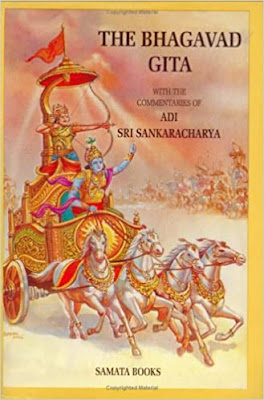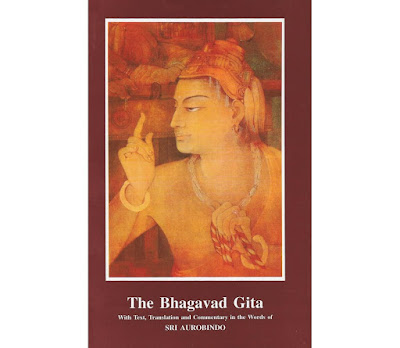Shrimad Bhagavad Gita: The essence of Vedas
“Bhagavad Gita” or “Shrimad Bhagavad Gita” the name which fascinates most of the people in their life. A book that ignites spirituality, gives a deeper understanding of life, provides a way to lead a more peaceful life. The book has now the highest popularity than ever before. Why? What is special about this book?
In my
childhood, I also have the same curiosity about this book. There were so many stories
revolving around the book. Some of them claimed that people became sanyasis (renounce
the social life) after reading this book. They would renounce their social life.
I always thought if that is the reason then why did Arjun not become a sanyasi
who himself heard it directly from the ultimate God “Krishna”.
The
curiosity grew large in me and one day I finally picked up the book to read. Trying
to not coming in sight of anyone while doing so. Was simply trying to avoid the
questions. That was the day and after more than 15 years that same book is
still with me. I have read it many times. It became my favorite book. I tried
to read commentaries on the Bhagavad Gita of various authors. From my experience, I am
suggesting some of them here.
First, the thing that must be kept in mind while reading this book, is that you should not
read it like a scholar. What I mean here is, don’t go for the literal meaning of
the words. When you read it like a scholar, the meaning is very much limited.
The beauty
of Bhagwat Gita is every time you read it, you learn something thing new.
The other
thing which is needed to keep in mind is, this conversation between Arjun and
Shri Krishna took place on the battlefield. The Arjun was reluctant to fight
against his elders and cousins. It is at that moment the ultimate God Krishna
opened delivered this wisdom yoga to Arjun. Gita talks about different ways of
yoga to live a truly joyful life and ultimately reach salvation.
You may
find something in the text which were meant for those time only (I have not
found anything like that till now but some claims). You should remain open-minded to it.
Most of
the Indians do not face any problems in understanding the true essence of
Bhagwat Gita but for some foreigners, there may be some difficulties. To
overcome this, I am suggesting some of the translations and commentaries of
Gita that is very useful to understand.
There are
many commentaries available around the world on this epic conversation between God and his disciple. But the question is which commentary we should read?
Which one is reliable? I would say you should avoid reading commentaries on
Bhagavad Gita. There are two types of commentaries. One is written by scholars
and the other by enlightened persons.
The
problem with scholars is that they take things literally. Their experience of
life is very much limited to the physical. However, yoga takes one from a limited physical experience to a non-physical one. These experiences are very much
needed to be able to comment on Gita. Only enlightened beings or Yogis can do
this.
I am
mentioning here the books that are written by enlightened beings only.
Most popular and reliable translations and commentaries on Bhagavad Gita
Best Commentaries on Bhagavad Gita
- Bhagavad Gita: God Talks with Arjun by Swami Paramhansa Yogananda
- Bhagavad Gita by Adi Shankracharya
- Bhagavad Gita as viewed by Swami Vivekananda
- Bhagavad Gita by Sri Aurobindo
- Bhagavad Gita: As it is by A C Bhaktivedanta Swami Prabhupada
God Talks with Arjun by Swami Paramhansa Yogananda
Swami Sri
Yukteshwar Giri once told his disciple about the importance of 1st
chapter of Gita. Yukteshwar Giri explained its verses to Sri Yogananda and
refused to explain the remaining chapters. He told that if you understand the 1st
chapter, you will have no problem in understanding the rest of it. Swami
Paramhansa Yogananda meditated on each verse for so long until it opened itself
in front of him in its entirety. That’s how “God talks with Arjun” was written.
The book
first gives a brief story of Mahabharat – The Indian historical tale - to make the reader comfortable. The main feature of his commentary is that he related the
characters of Mahabharat with the psychological and physical features of the human
body and mind. And this gives a whole new dimension to this enlightening
conversation.
This book
is my personal favorite and has been reading it continuously for many years.
God talks with Arjun gives a very deep insight into yoga.
Bhagavad Gita by Sri Adi Shankracharya
It is
being said that after the time period of Mahabharat, the knowledge of Yoga and
Bhagavad Gita disappeared slowly from the common masses. In 800AD, Adi
Shankracharya wrote his commentary on Bhagavad Gita in simple language and made
it available to the common masses again. From that time, this text has been
preserved and still available to read. He was an enlightened being and his
insights on this sacred text are unparalleled.
Bhagavad Gita as viewed by Swami Vivekananda
Swami
Vivekananda – the fiery and energetic yogi of the 19th century – brought
the concept of yoga to the western world. Swami Ji became famous for his speech at
the world religion congress on 11 September 1893 at Chicago University. His
statue stands tall at Chicago University today.
Vivekananda
never wrote a book in his life. His talks and teachings are preserved by his
disciples and are available as the complete works of Swami Vivekananda in 9
volumes.
Bhagavad
Gita as viewed by Swami Vivekananda is the collection of his talks on Gita
given on various occasions and are compiled by his disciple Swami Madhurananda.
Bhagavad Gita or Essays on the Gita by Sri Aurobindo
The Indian
Nationalist and freedom fighter turned yogi, Sri Aurobindo wrote the
translation of Gita. It was first published in 1938 as “The message of Gita” edited
by Anilbaran Roy. The book was compiled from Sri Aurobindo’s essays on the
Gita. The Bhagavad Gita by Aurobindo is not a direct translation of the text
rather it’s an explanatory text. It helps in the easy understanding of Gita’s
verses. Sri Aurobindo was an enlightened being who became spiritual during his
days in jail. He left to Puducherry and started his own Yoga Ashram. He developed
his own yogic process called Integral Yoga. You can read more about his
technique of yoga in his book “The synthesis of Yoga”.
Bhagavad Gita: As it is by A C Bhaktivedanta Swami Prabhupada
It is not
possible that people who wish to read Bhagavad Gita might not hear about ISKON
or Hare Krishna movement. Swami Prabhupada founded “International Society of
Krishna Consciousness” or “Hare Krishna Movement” in 1966. From that day onwards,
ISKON has spread like a sweet aroma around the world. It has followers all
around the world.
First An abridged edition of Bhagavad Gita as it is was published in 1966 with 400
pages. When it became popular, the publishers agreed to publish the complete
edition of Bhagavad Gita as it is 1000 pages. This is the original book that
was written by Swami Prabhupada.
Later, Bhakti Vedanta Trust published an edited and revised edition of the book which brought a lot of criticism from Swami Prabhupada’s devotees. Now both original and revised editions are available. I suggest going for the original version as it was published in presence of Swami Prabhupada. Bhagavad Gita as it is is available in more than 59 languages including French, Russian, German, Italian, Portuguese, Swedish, Ukrainian, and many more.
Commentaries on Bhagavad Gita, I listed here are my personal favorites. I do not belittle the commentaries written by other spiritual personalities. There are many more commentaries on Gita by Swami Chinmayananda, Osho, Madhava Charya, and so on.










0 Comments